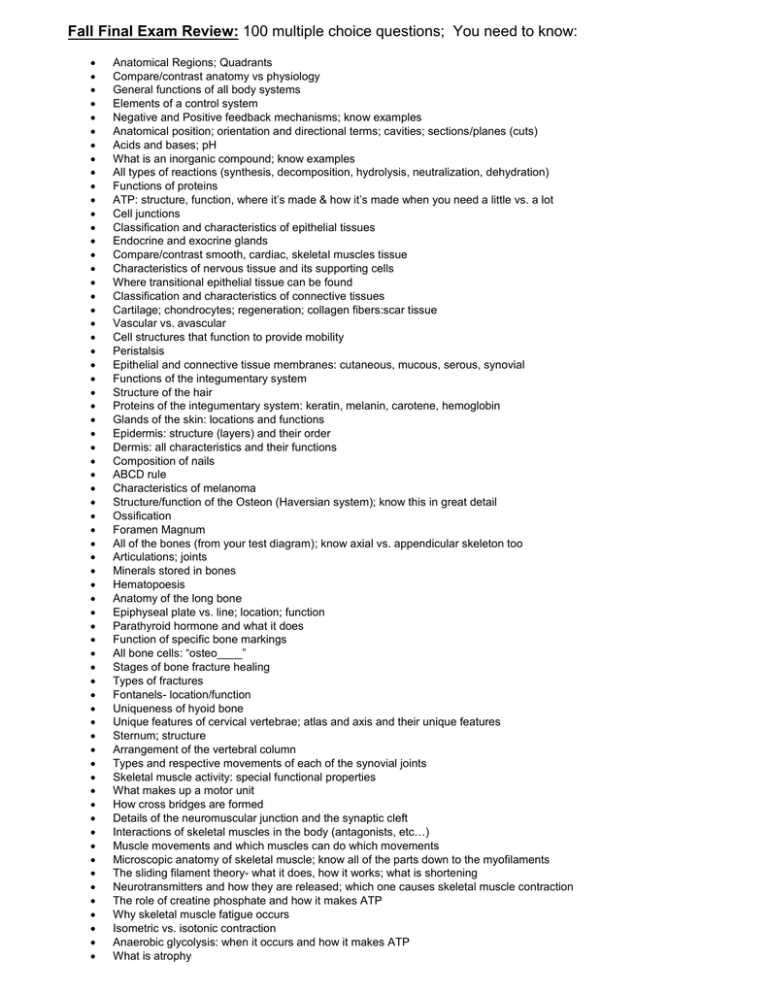Fall Final Exam Review:
advertisement

Fall Final Exam Review: 100 multiple choice questions; You need to know: Anatomical Regions; Quadrants Compare/contrast anatomy vs physiology General functions of all body systems Elements of a control system Negative and Positive feedback mechanisms; know examples Anatomical position; orientation and directional terms; cavities; sections/planes (cuts) Acids and bases; pH What is an inorganic compound; know examples All types of reactions (synthesis, decomposition, hydrolysis, neutralization, dehydration) Functions of proteins ATP: structure, function, where it’s made & how it’s made when you need a little vs. a lot Cell junctions Classification and characteristics of epithelial tissues Endocrine and exocrine glands Compare/contrast smooth, cardiac, skeletal muscles tissue Characteristics of nervous tissue and its supporting cells Where transitional epithelial tissue can be found Classification and characteristics of connective tissues Cartilage; chondrocytes; regeneration; collagen fibers:scar tissue Vascular vs. avascular Cell structures that function to provide mobility Peristalsis Epithelial and connective tissue membranes: cutaneous, mucous, serous, synovial Functions of the integumentary system Structure of the hair Proteins of the integumentary system: keratin, melanin, carotene, hemoglobin Glands of the skin: locations and functions Epidermis: structure (layers) and their order Dermis: all characteristics and their functions Composition of nails ABCD rule Characteristics of melanoma Structure/function of the Osteon (Haversian system); know this in great detail Ossification Foramen Magnum All of the bones (from your test diagram); know axial vs. appendicular skeleton too Articulations; joints Minerals stored in bones Hematopoesis Anatomy of the long bone Epiphyseal plate vs. line; location; function Parathyroid hormone and what it does Function of specific bone markings All bone cells: “osteo____” Stages of bone fracture healing Types of fractures Fontanels- location/function Uniqueness of hyoid bone Unique features of cervical vertebrae; atlas and axis and their unique features Sternum; structure Arrangement of the vertebral column Types and respective movements of each of the synovial joints Skeletal muscle activity: special functional properties What makes up a motor unit How cross bridges are formed Details of the neuromuscular junction and the synaptic cleft Interactions of skeletal muscles in the body (antagonists, etc…) Muscle movements and which muscles can do which movements Microscopic anatomy of skeletal muscle; know all of the parts down to the myofilaments The sliding filament theory- what it does, how it works; what is shortening Neurotransmitters and how they are released; which one causes skeletal muscle contraction The role of creatine phosphate and how it makes ATP Why skeletal muscle fatigue occurs Isometric vs. isotonic contraction Anaerobic glycolysis: when it occurs and how it makes ATP What is atrophy



